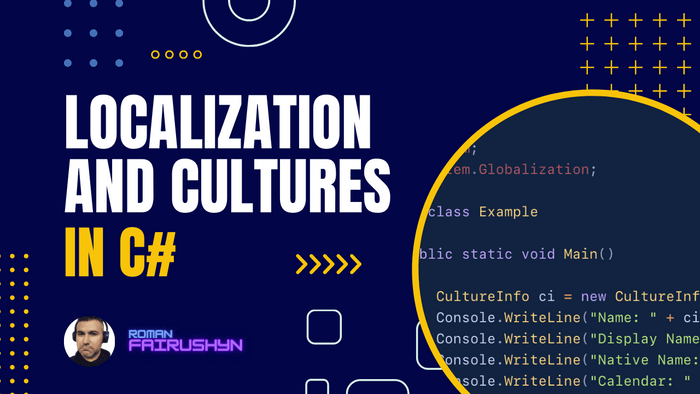Localization and Cultures in C#
4 min read · — #csharp-interview#middle-specialist#localization#cultures
In the global village of today's tech world, a software application's reach isn't restricted to just one region or one group of people. As software engineers, we pride ourselves on creating scalable and adaptable systems. Yet, scaling in terms of geography and culture often requires more finesse than meets the eye. Enter "Localization" – the unsung hero of global software applications.
Localization isn't just translating words; it's an art of adapting software to different languages, regional peculiarities, and technical requirements of a target market. For C# developers, this is where understanding cultures in the .NET framework becomes indispensable. In this post, we will unravel the complexities of localization in C#, illustrating with examples, and prepare you for any related questions that might come up in a technical interview. Let’s journey through the world of cultures – without leaving our IDE.
1. The Basics: CultureInfo Class
The heart of understanding cultures in C# lies in the CultureInfo class. It provides information about a specific
culture, like its name, the calendar used, the sort order of strings, and more.
Example:
using System;
using System.Globalization;
public class Example
{
public static void Main()
{
CultureInfo ci = new CultureInfo("fr-FR");
Console.WriteLine("Name: " + ci.Name);
Console.WriteLine("Display Name: " + ci.DisplayName);
Console.WriteLine("Native Name: " + ci.NativeName);
Console.WriteLine("Calendar: " + ci.Calendar);
}
}2. Date and Time Formatting
Date and time representation varies greatly across cultures. Using the DateTime structure with CultureInfo can help
you handle these variations.
Example:
CultureInfo ciUS = new CultureInfo("en-US");
Console.WriteLine(DateTime.Now.ToString("D", ciUS));
// Outputs: Wednesday, 23 August 2023
CultureInfo ciFR = new CultureInfo("fr-FR");
Console.WriteLine(DateTime.Now.ToString("D", ciFR));
// Outputs: mercredi 23 août 20233. Number and Currency Formatting
How you represent numbers, especially currency, can be vastly different across cultures. Let's see how we can handle this:
Example:
double value = 12345.67;
Console.WriteLine(value.ToString("C", ciUS));
// Outputs: $12,345.67
Console.WriteLine(value.ToString("C", ciFR));
// Outputs: 12 345,67 €4. Resource Files (.resx) for Localization
In C#, resource files are a way to store localized content. These can be strings, images, or other content types. The Resource Manager class can then be used to retrieve these values based on the current culture.
Example:
Imagine we have two resource files:
Messages.resxwith a Name-Value pair:WelcomeMessage = "Welcome"Messages.fr-FR.resxwith a Name-Value pair:WelcomeMessage = "Bienvenue"
We can retrieve the localized message as:
CultureInfo.CurrentUICulture = new CultureInfo("fr-FR");
string message = Resources.Messages.WelcomeMessage;
Console.WriteLine(message); // Outputs: Bienvenue5. Considerations and Tips for the Interview
-
Always Think Global, Act Local: Even if the current project doesn't require localization, structure your code in a way that adding localization later won't require major rewrites.
-
Right-to-Left Languages: Some languages, like Arabic, are written right-to-left. Ensure your UI can handle and display such languages correctly.
-
Cultural Sensitivities: Localization isn't just about language. Colors, icons, and even certain words might have different connotations in different cultures.
6. Efficient Usage of CultureInfo
Using CultureInfo effectively is crucial, not only for writing clean code but also for optimizing performance. One
might be tempted to instantiate a new CultureInfo every time it's required, but this isn't the most efficient
approach. Let's delve into why:
-
Memory Overhead: Constructing a
CultureInfoobject means it's held in memory. Doing this repetitively can result in unnecessary memory consumption, especially if you're frequently utilizing the same cultural settings. -
Performance Overhead: The process of constructing a new
CultureInfoobject involves loading and caching a variety of internal data. This can be time-consuming, particularly when compared to simply reusing an already instantiated object. -
Framework's Caching: While .NET does cache
CultureInfoobjects to some extent, constantly creating new instances and relying on the framework's cache is not the optimal approach. Directly managing and reusing your own references is more efficient.
Recommended Approach:
To bypass these overheads and streamline your code's efficiency, consider caching frequently used CultureInfo objects. Here's how you can do it:
public static class CultureConstants
{
public static readonly CultureInfo FrenchCulture =
new CultureInfo("fr-FR");
// ... other cultures
}By referencing, for example, CultureConstants.FrenchCulture, you're ensuring minimal overhead and optimized performance.
Conclusion
To wrap up, mastering localization in C# is not just about knowing the tools and the classes. It's about acknowledging and respecting the diversity of your users. As software engineers, our job isn't only to solve problems but to build bridges across cultures, and in C#, localization is a powerful tool in our arsenal to do just that.
